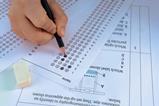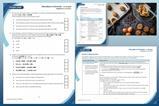How a creative approach can reveal and resolve students’ confusion about displacement reactions

Teaching displacement reactions is all too often a minefield of misconceptions. To grasp the underlying concepts fully, students not only need to recognise chemical formulas, but also to understand reorganisation of atoms during reactions. This is before we add in difficult-to-interpret experiments, with a number of potential observations and many seemingly ‘false positive’ results when substances are mixed together. For example, adding iodine solution to chlorine water when teaching halogen displacement – yes, the chlorine water starts off colourless and ends up a pale brown colour, but this is not indicative of a displacement.
Tenacious misconceptions may not always be obvious in your students’ work until you start trying to apply their understanding to exam-style questions and explanations. This is what led me to seek a new solution to busting confusion early with an easy, impactful visual task which engages my students.
Demonstrating displacement
After a lesson learning about displacement reactions and doing a practical, I send students away with a homework task to create a video demonstrating how a displacement reaction works on a particle scale. They can use apps such as Stop Motion to simply stitch together a series of photos, but I give them complete creative freedom. We upload their work to Teams (our school’s chosen online platform) for review. The only rules I give are:
1. the video must be less than 45 seconds; and
2. students must include a key to show the different atom types.
After a lesson learning about displacement reactions and doing a practical, I send students away with a homework task to create a video demonstrating how a displacement reaction works on a particle scale. They can use apps such as Stop Motion to simply stitch together a series of photos, but I give them complete creative freedom. We upload their work to Teams (our school’s chosen online platform) for review. The only rules I give are that the video must be less than 45 seconds and that students must include a key to show the different atom types.
For students who prefer to work offline, I give the option of a cartoon strip. However most students enjoy the opportunity to creatively use technology. If you are worried about students having access to devices, you can turn this into a group task, or integrate it into your lessons using school devices. For this activity to be most impactful, however, I find it works best as an individual task. Then you can really gauge what pupils are thinking.
I was surprised by how successfully this activity exposed misunderstandings. Seemingly just a fun way of integrating technology and creativity into my homeworks, it gave me much more meaningful information than completing word and symbol equations or exam questions ever has. The most common misconceptions include:
1. which metal (or halogen) needs to be more reactive: the one being added, or the one in the compound?
2. how chemical reactions work: do compounds spontaneously ‘break apart’ before reconfiguring themselves?
3. the need to balance these equations to account for the diatomic molecules in halogen displacement reactions at 14–16.
The best part about this task is how easy it is to spot these thinking errors without investing much time marking. Plus I was able to design meaningful, differentiated follow-up tasks. For example, I ask students with misconception 1 to explain why some displacement reactions could occur while others could not. This helps them to recognise which element needs to be more reactive for displacement to occur. I give students with misconception 3 a series of equations to complete and balance.
I was surprised by how successfully this activity exposed misunderstandings. Seemingly just a fun way of integrating technology and creativity into my homeworks, it gave me much more meaningful information than completing word and symbol equations or exam questions ever has. The most common misconceptions include which metal (or halogen) needs to be more reactive; how chemical reactions work; and the need to balance these equations to account for the diatomic molecular halogens for halogen displacement at 14–16.
The best part about this task is how easy it is to spot these thinking errors without investing much time marking. Plus I was able to design meaningful, differentiated follow-up tasks. For example, I ask students with misconception 1 to explain why some displacement reactions could occur while others could not. This helps them to recognise which element needs to be more reactive for displacement to occur. I give students with the balancing equation misconception a series of equations to complete and balance.
Taking it further
I have carried this idea throughout my scheme of work. The same activity can show how some metals are extracted by reduction with carbon. With 14–16 students, the task can show the role of the spectator ions within solutions. This can lead into a task where students build their own ionic equations by removing these spectator ions. The visuals can really aid understanding. You can take this further by producing half-equations to show redox equations. You could even incorporate this task into other topics to show the movement of acidic protons during neutralisation to gradually build student understanding. For example, ask 11–14 learners, which part of an acid is responsible for reactivity; ask 14–16 students, how to construct redox equations; and ask post-16 students, how to identify conjugate base-pairs.
Probing student understanding with this task and then scaffolding their learning using a variety of mediums to break down the key ideas has worked wonders. It has allowed me to spot misconceptions early and put tasks in place to help combat them. Plus, it’s a quick and fun task for my students.














No comments yet